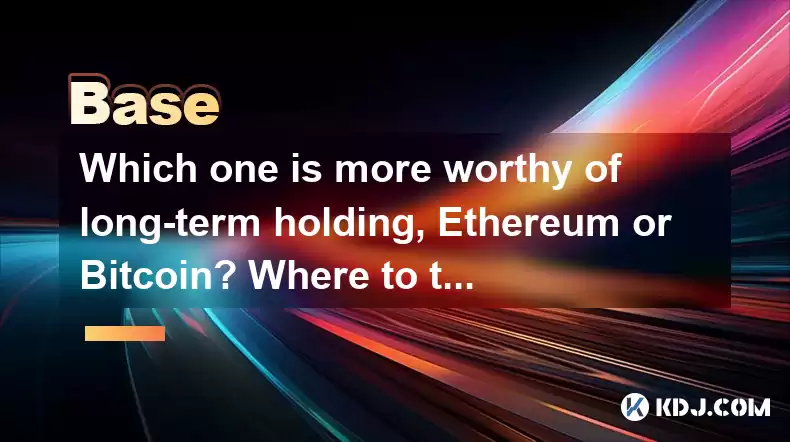-
 Bitcoin
Bitcoin $114400
0.68% -
 Ethereum
Ethereum $3550
2.48% -
 XRP
XRP $3.001
4.99% -
 Tether USDt
Tether USDt $0.9999
0.01% -
 BNB
BNB $757.6
1.46% -
 Solana
Solana $162.9
1.07% -
 USDC
USDC $0.9998
0.00% -
 TRON
TRON $0.3294
0.91% -
 Dogecoin
Dogecoin $0.2015
2.46% -
 Cardano
Cardano $0.7379
2.01% -
 Stellar
Stellar $0.4141
8.83% -
 Hyperliquid
Hyperliquid $37.83
-1.91% -
 Sui
Sui $3.454
0.76% -
 Chainlink
Chainlink $16.62
3.53% -
 Bitcoin Cash
Bitcoin Cash $554.6
2.84% -
 Hedera
Hedera $0.2486
3.91% -
 Ethena USDe
Ethena USDe $1.001
0.00% -
 Avalanche
Avalanche $21.95
3.34% -
 Toncoin
Toncoin $3.563
-2.85% -
 Litecoin
Litecoin $112.7
2.65% -
 UNUS SED LEO
UNUS SED LEO $8.977
0.13% -
 Shiba Inu
Shiba Inu $0.00001232
1.85% -
 Uniswap
Uniswap $9.319
2.93% -
 Polkadot
Polkadot $3.632
1.38% -
 Monero
Monero $307.2
2.36% -
 Dai
Dai $0.9997
-0.03% -
 Bitget Token
Bitget Token $4.340
0.91% -
 Pepe
Pepe $0.00001048
1.07% -
 Cronos
Cronos $0.1348
3.26% -
 Aave
Aave $261.5
1.93%
Which one is more worthy of long-term holding, Ethereum or Bitcoin? Where to trade?
比特币和以太坊可在币安、Coinbase、OKX和火币交易,选择长期持有需考虑市场表现、技术特点、应用场景及风险特征。
Apr 27, 2025 at 04:42 am

比特币和以太坊可以在以下平台进行交易:
- 币安(Binance):作为全球领先的加密货币交易平台之一,币安支持比特币和以太坊等多种加密货币的交易。该平台以其高速交易、充足的流动性以及丰富的交易对和多样化的交易功能著称,服务范围覆盖全球超过180个国家和地区。
- Coinbase:作为美国最大的加密货币交易所之一,Coinbase以其合规性和安全性而闻名,是首家获得美国正规牌照的比特币交易所。该平台为个人和机构提供比特币和以太坊等交易服务,并实时监控虚拟货币价格的变动。
- OKX(欧易):这是一个全球知名的数字资产交易平台,提供比特币、以太坊等多种数字资产的现货和衍生品交易服务。其服务覆盖200多个国家和地区,拥有千万级的用户群体。
- 火币(huobi):总部位于新加坡的火币是全球性的加密货币交易平台,在加密货币交易领域享有较高的知名度和市场份额,提供比特币、以太坊等多种数字资产的交易服务。
比特币和以太坊都是加密货币领域的重要代表,选择哪个更值得长期持有需要综合考虑多方面因素:
- 市场表现:从历史和近期数据来看,比特币的市值与实现价值比(MVRV)连续812天高于以太坊,自2023年以来,比特币投资者的平均累积利润显著超过以太坊投资者。在2022年11月至2024年期间,比特币的实现市值增长幅度也大于以太坊。在2024年10月至12月的牛市中,比特币价格飙升近70%,而同期以太坊的涨幅不足50%。然而,以太坊作为市值第二的加密资产,凭借其庞大的生态系统和技术创新潜力,未来也有可能迎来反弹。
- 技术特点:比特币采用工作量证明(PoW)机制,具有较高的安全性,但能源消耗大,交易速度较慢,且脚本语言非图灵完备,限制了其功能扩展。以太坊最初也采用PoW机制,但在2022年9月完成“合并”后转向权益证明(PoS)机制,降低了能源消耗,提高了交易处理速度。其智能合约语言是图灵完备的,允许开发者编写复杂的逻辑代码,支持各种功能,为去中心化应用(DApp)开发提供了强大的平台。
- 应用场景:比特币主要作为价值存储和跨境支付工具,其总量2100万枚的稀缺性使其被称为“数字黄金”,具有一定的抗通胀能力,且跨境交易成本低、速度快。然而,其交易速度慢的特性限制了在大规模支付场景中的应用。以太坊则构建了丰富的去中心化应用生态,涵盖去中心化金融(DeFi)、非同质化代币(NFT)、DApp等多个领域,如Aave借贷平台、Uniswap去中心化交易所等,在金融、游戏、社交等领域应用广泛。
- 风险特征:比特币面临的主要风险包括市场波动、监管政策的不确定性以及技术漏洞等。作为加密货币的先驱,比特币受到的监管关注度较高,各国政策的变化可能对其价格产生重大影响。以太坊除了市场和监管风险外,还面临智能合约漏洞、网络安全等风险,历史上曾发生过The DAO事件等因智能合约漏洞导致的安全问题。
如果你更倾向于稳健的价值存储和简单的交易功能,比特币可能是更好的选择;如果你看好区块链技术在金融和其他领域的广泛应用,愿意承担一定的风险以获取更高的潜在收益,以太坊或许更值得长期持有。
Disclaimer:info@kdj.com
The information provided is not trading advice. kdj.com does not assume any responsibility for any investments made based on the information provided in this article. Cryptocurrencies are highly volatile and it is highly recommended that you invest with caution after thorough research!
If you believe that the content used on this website infringes your copyright, please contact us immediately (info@kdj.com) and we will delete it promptly.
- Cryptocurrency, Altcoins, and Profit Potential: Navigating the Wild West
- 2025-08-04 14:50:11
- Blue Gold & Crypto: Investing Disruption in Precious Metals
- 2025-08-04 14:30:11
- Japan, Metaplanet, and Bitcoin Acquisition: A New Era of Corporate Treasury?
- 2025-08-04 14:30:11
- Coinbase's Buy Rating & Bitcoin's Bold Future: A Canaccord Genuity Perspective
- 2025-08-04 14:50:11
- Coinbase's Buy Rating Maintained by Rosenblatt Securities: A Deep Dive
- 2025-08-04 14:55:11
- Cryptos, Strategic Choices, High Returns: Navigating the Meme Coin Mania
- 2025-08-04 14:55:11
Related knowledge

What is the difference between CeFi and DeFi?
Jul 22,2025 at 12:28am
Understanding CeFi and DeFiIn the world of cryptocurrency, CeFi (Centralized Finance) and DeFi (Decentralized Finance) represent two distinct financia...

How to qualify for potential crypto airdrops?
Jul 23,2025 at 06:49am
Understanding What Crypto Airdrops AreCrypto airdrops refer to the distribution of free tokens or coins to a large number of wallet addresses, often u...

What is a crypto "airdrop farmer"?
Jul 24,2025 at 10:22pm
Understanding the Role of a Crypto 'Airdrop Farmer'A crypto 'airdrop farmer' refers to an individual who actively participates in cryptocurrency airdr...

What is the difference between a sidechain and a Layer 2?
Jul 20,2025 at 11:35pm
Understanding the Concept of SidechainsA sidechain is a separate blockchain that runs parallel to the main blockchain, typically the mainnet of a cryp...

What is the Inter-Blockchain Communication Protocol (IBC)?
Jul 19,2025 at 10:43am
Understanding the Inter-Blockchain Communication Protocol (IBC)The Inter-Blockchain Communication Protocol (IBC) is a cross-chain communication protoc...

How does sharding improve scalability?
Jul 20,2025 at 01:21am
Understanding Sharding in BlockchainSharding is a database partitioning technique that is increasingly being adopted in blockchain technology to enhan...

What is the difference between CeFi and DeFi?
Jul 22,2025 at 12:28am
Understanding CeFi and DeFiIn the world of cryptocurrency, CeFi (Centralized Finance) and DeFi (Decentralized Finance) represent two distinct financia...

How to qualify for potential crypto airdrops?
Jul 23,2025 at 06:49am
Understanding What Crypto Airdrops AreCrypto airdrops refer to the distribution of free tokens or coins to a large number of wallet addresses, often u...

What is a crypto "airdrop farmer"?
Jul 24,2025 at 10:22pm
Understanding the Role of a Crypto 'Airdrop Farmer'A crypto 'airdrop farmer' refers to an individual who actively participates in cryptocurrency airdr...

What is the difference between a sidechain and a Layer 2?
Jul 20,2025 at 11:35pm
Understanding the Concept of SidechainsA sidechain is a separate blockchain that runs parallel to the main blockchain, typically the mainnet of a cryp...

What is the Inter-Blockchain Communication Protocol (IBC)?
Jul 19,2025 at 10:43am
Understanding the Inter-Blockchain Communication Protocol (IBC)The Inter-Blockchain Communication Protocol (IBC) is a cross-chain communication protoc...

How does sharding improve scalability?
Jul 20,2025 at 01:21am
Understanding Sharding in BlockchainSharding is a database partitioning technique that is increasingly being adopted in blockchain technology to enhan...
See all articles

























































































